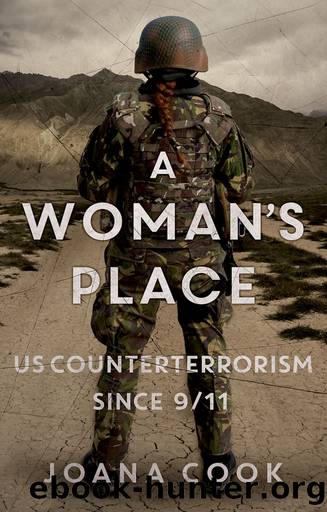A Woman's Place by Joana Cook

Author:Joana Cook
Language: eng
Format: epub
Publisher: Oxford University Press
Published: 2019-08-15T00:00:00+00:00
CVE: Expanding space for women in security
As reflected in both the QDDR and the NAP implementation plan, the rising prominence of CVE opened further opportunities for US State to extend its policy and programming to women. Former Acting Coordinator for Counterterrorism in US State and US Ambassador to Yemen (1997–2001) Barbara Bodine noted that this important emphasis on CVE was shifting back to root causes, grievances and precursors, which also integrated further considerations of development: “[CVE is] trying to get ahead of the curve and instead of doing security, then attempting to address issues of development, ‘we better start working on some of these other areas first’. [It is] shifting.”100
Of the varied streams of effort related to counterterrorism, CVE appeared to emphasize women most expansively and directly for several reasons, including those both based on gendered stereotypes related to women, but also on practical realities that had been raised with ISIS. First, CVE efforts most frequently emphasized civil society, community or familial positions that women were commonly understood to hold (versus those such as security practitioners). This also extended to areas such as advocacy or counter-narratives, where women were seen as key conduits to disseminate messages challenging groups like ISIS, or engaging in debates to help prevent their family members from becoming radicalized.
Women were also increasingly targeted in ISIS recruitment, including by female recruiters, so women in CVE efforts were sometimes viewed as most suitable to engage other women. Women were also viewed as having particularly authentic voices able to specify when they were victims of terrorist violence or when they lost family members to such organizations, providing useful counter-narratives.101 However, this could still problematically reinforce victimhood stereotypes of women in relation to security or limit the space by which their concerns related to security may be raised, demonstrating the continuous tensions in such efforts. Furthermore, CVE did not necessarily carry with it the same negative stigmas and grievances that had been associated with some DoD actions previously, such as extraordinary renditions, torture or other human rights violations.
CVE thus presented a new stream of counterterrorism-related work in indirect or soft power efforts where women could be engaged afresh. This aligned with the pre-existing and socially resonant roles that women had traditionally held, and which were reflective of earlier US State programming focused on women. By 2012, US State was significantly emphasizing women in its CVE efforts, noting for example in its annual globally reaching Country Report on Terrorism:
CVE programming places particular emphasis on engaging women; women are uniquely positioned to counter radicalization both at home and in their communities and are therefore a vital component of our efforts. We continued to support the networking of CVE women activists. Lastly, we sought to amplify the voices of victims of terrorism who can credibly articulate the destructive consequences of terrorism, and can thus help to dissuade those contemplating such acts.102
Eileen O’Connor, US Deputy Assistant Secretary of State for South and Central Asian Affairs, also echoed these themes of women in community roles,
Download
This site does not store any files on its server. We only index and link to content provided by other sites. Please contact the content providers to delete copyright contents if any and email us, we'll remove relevant links or contents immediately.
100 Techniques: Master a Lifetime of Cooking Skills, From Basic to Bucket List by America's Test Kitchen(907)
Barefoot in Paris: Easy French Food You Can Make at Home by Ina Garten(798)
Eating Out Loud : Bold Middle Eastern Flavors for All Day, Every Day: a Cookbook (9780593135884) by Grinshpan Eden(762)
Wheat Belly by MD William Davis(751)
The Flavor Equation by Nik Sharma(746)
The Curry Guy Thai by Dan Toombs(731)
Dumplings and Noodles by Pippa Middlehurst(725)
To Asia, With Love by Hetty McKinnon(716)
MasterChef the Classics with a Twist by MasterChef(678)
A Blissful Feast by 449943184(666)
Baking by Dorie Greenspan(664)
Fix-It and Forget-It Mediterranean Diet Cookbook by Hope Comerford(654)
Gordon Ramsay Quick and Delicious: 100 Recipes to Cook in 30 Minutes or Less by Gordon Ramsay(653)
Betty Crocker Kids Cook (Betty Crocker Cooking) by Betty Crocker(628)
Food on the go: Sumptuous Food Truck Recipes by Heston Brown(622)
Bon Appetit, Y'all: Recipes and Stories From Three Generations of Southern Cooking by Virginia Willis; Ellen Silverman(609)
The World Cookbook by Jeanne Jacob-Ashkenazi(607)
The Chopped Cookbook: Use What You've Got to Cook Something Great by Food Network Kitchen(579)
Living High Off the Hog: Over 100 Recipes and Techniques to Cook Pork Perfectly by Michael Olson(563)
